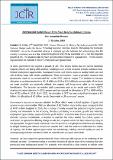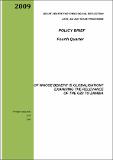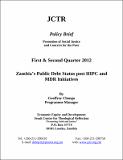Public Finance Management: Recent submissions
Now showing items 21-40 of 50
-
Does Aid Transparency Make for More Effective Aid? A Case Study of Lusaka Province
(2011)The movement for increasing aid transparency has gained significant momentum in recent years. The purpose of this study is to analyze the link between aid transparency and aid effectiveness. Several studies do not corroborate ... -
Domestic Resource Mobilisation For Sustainable Development
(2014)TPIN stands for Tax Payer Identification Number. It can be likened to a National Registration Card (NRC) number for a Zambian citizen. It is the official ten (10) digits number that ZRA issues to a Tax registered individual ... -
Domestic Resource Mobilisation For Sustainable Development
(2008)To ensure that there is equity in bearing the tax burden. The tax burden in Zambia is borne largely by about 500, 000 workers in the formal sector. There is need to ensure that equity prevails where all contribute to the ... -
The Proposed Refinancing Strategy of US $750 Million Eurobond Might Lead Zambia Into A Sovereign Debt Crisis
(2019)The planned contraction of a private equity to amortize Zambia’s US$ 750 million Eurobond is a disaster in-waiting. JCTR is apprehensive with regard to use of a private equity to refinance the country’s Eurobond as the ... -
Media Statement on Public Finance Management In Zambia
(2017)The members of civil society are concerned with the current public financial management situation within which we find ourselves as Zambians. The Auditor General’s Report every year reveals how colossal sums of money are ... -
Tilting The Scale in Favour of Borrowing And it’s Risks
(2020-01-15)The paper talks about the rise of Zambia’s external debt over the past few years. According to the Ministry of Finance data, Zambia’s domestic debt stock in terms of securities and bonds rose in 2011. Against this back ... -
Wastage Of Public Resources Should Never Be Allowed To Continue
(2012-02-01)In a poor country like Zambia where poverty levels are as high as 63% and the incidence of rural poverty as high as 78%, every ngwee counts and should therefore be collected and spent for the intended purpose and beneficiaries. ... -
Continued Increase in Public Funds Abuse/Waste Worrying
(2017-11-08)Zambia has many developmental challenges to continue on the path of wasteful use of public resources. In the last few years, government has struggled to balance its incomes with expenditure partly due to reduced economic ... -
JCTR’s Reflections on the 2020 National Budget
(2020)The JCTR’s Kasama Office has over the years been engaged in advocacy and lobbying of policy makers in order to promote social justice for all people epically the poor. On 4th July, 2019, stakeholders drawn from Health, ... -
Press Statement on The Auditor General’s Report on The Accounts of The Republic For The Financial Year Ended 31St December, 2013
(2013)The Report is rather gloomy and bleak in respect of the utility of public resources pointing to prevalence of resource disutility in the public service. There are many questions than answers regarding the operation of the ... -
2020 National Budget Doesn’t Offer Much Relief to Ordinary Citizens
(2019-10-01)In 2020, government has targeted a growth of 3%. This simply means that the current hardships majority citizens are facing will continue. Challenges such as lack of access to basic nutritious food, limited employment ... -
Implementation of Select Health Projects at Livingstone Central Hospital
(2018)Over the years, the Jesuit Centre for Theological Reflection (JCTR) has monitored the use of public financial resources in an effort to foster accountability by public officers. Some works have included analysing issues ... -
An Assessment of The Problems / Obstacles Faced By Informal Cross Border Traders in Zambia: The Case For Chipata And Livingstone Towns
(2002)This study assesses the problems / obstacles faced by informal cross border traders in Zambia, using Chipata and Livingstone towns as case studies. The; study ’was done with the understanding that Zambia is part of the ... -
Zambia’s Experience With HIPC
(2004)The HIPC Initiative was first launched in 1996 by the International Monetary Fund (IMF) and the World Bank, with the aim of ensuring that no poor country faces a debt burden it cannot manage. The Initiative entails coordinated ... -
Of Whose Benefit is Globalisation? Examining the Relevance of the G20 to Zambia
(2009)The G20, unlike other forms of international cooperations like the United Nations, is an informal forum that promotes discussion between industrialised and emerging-market countries on key issues related to global economic ... -
Zambia After The HIPC ‘Surgery’ And The Completion Point
(2006)“We reached the heavily indebted poor countries (HIPC) Completion Point in April 2005 and so what?” asked a workshop participant in one of the Jubilee-Zambia Provincial Workshops. Indeed many other Zambians are asking ... -
Analysis of The Reports of The Auditor General on The Accounts For The Financial Year Ended 31St December 2015 And Review of Operations of Local Authorities For 2015
(2017)The JCTR has over the years advocated improvement in Zambian citizens’ access to essentials of life. They include access to education, health, water and sanitation. Select cases of concern have therefore been identified ... -
Resource Mobilization For Sustainable Development: Best Practices
(2011)Every government needs to mobilize financial resources to finance its development programme. The need to mobilize sufficient financial resources is even more urgent for developing countries like Zambia, as they have more ... -
Economic Partnership Agreements: A Challenge for Trade Justice
(2007)In the last three years, the Debt and Trade Project (now Debt Aid and Trade Programme, DAT) of the Jesuit Centre for Theological Reflection (JCTR) invested in understanding the trade challenges faced by Zambia and other ... -
Zambia’s Public Debt Status Post HIPC And MDR Initiatives
(2012)The Public Debt reforms that the Zambian Government embarked on in 2004 aimed at strengthening debt management capacities of various Government institutions engaged in debt management should be accelerated. Currently, the ...




















